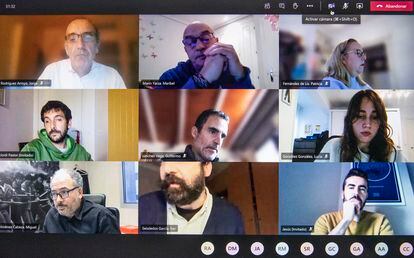How EL PAÍS transitioned to remote journalism during the pandemic
With newsrooms lying empty, reporters and editors had to quickly learn how to put out the paper from their homes
/cloudfront-eu-central-1.images.arcpublishing.com/prisa/DANEPP5P2BCLHIDIAMFWERO7EE.jpg)

At 7.45pm on Saturday, March 21, the front page of the first edition of EL PAÍS ever made from the homes of its journalists was sent to its most senior members of staff via WhatsApp. It read “The war of our generation” and went on to describe the coronavirus crisis in Spanish hospitals’ intensive care units.
That day, the news organization’s 420 employees, who normally work in newsrooms in Spain, Mexico and Brazil, as well as in the field as correspondents, did what other journalists across the world had to do: they produced their web and paper editions from their own homes. And they continue to do so.
Mónica Ceberio, a managing editor and head of newsroom coordination at EL PAÍS, drew up a teleworking schedule even before the state of alarm was declared. As more worrying news came in, the newsroom grew gradually emptier. With each spike, another department left the building. National news desk journalist Fernando J. Pérez was among the last to vacate the premises. “The newsroom was as depressing as the ghost town that Madrid had become,” he recalls.
The newspaper was not 100% prepared for the switch to remote working. What would usually have been done gradually over at least a year was organized in a matter of days, and involved obtaining hundreds of computers, licenses for remote editing systems and telephones. “It was a chaotic mix of nerves and insecurity,” says Rosario García, a newsroom secretary and one of the key players in the logistics of the operation. “We had to learn to work from home in 15 days.” In view of the strict general lockdown introduced by the Spanish government in mid-March, the management team decided that the entire staff should leave the headquarters on Miguel Yuste street, in Madrid.

Organizing how to put a newspaper together from a distance was not easy. There are reporters who are used to working outside the newsroom. But for others, such as those responsible for the page layout, it was a first. But they did it.
The same happened with the production teams that ensure everything is correct before going to print. Technology was the company’s main ally. The digital edition of that first day was put together without a hitch, and the paper edition was closed on time. Soledad Gallego-Díaz, the editor-in-chief at the time, said she felt “the impressive strength of this newspaper, which can be made, both on paper and online, from home.”
Those in charge of updating the digital edition, where constant communication is decisive, had already established a collective and permanent videoconferencing system that included the teams responsible for the front page and those in charge of last-minute stories. The system has run continuously since March, thanks to relays every seven hours, from 6am to 2am. And it will continue to do so until everyone returns to the newsroom. New schedules were drawn up for virtual meetings and a manual was partially put together on how to produce a newspaper remotely.
Maribel Marín, head of the society desk, which has dealt with much of the medical information issuing from the coronavirus pandemic, says that “it’s been crazy with the meetings on screens and on the phone, but it’s the only way to be in touch with everyone. It has made it easier to get the information that allows us to understand all the aspects of this dramatic situation.”
Xosé Hermida, then in charge of the national news desk, adds: “At first it seemed a miracle that a newspaper could get through like this, without any catastrophes or huge mistakes. Now it has become routine.”
It’s been crazy with the meetings on screens and on the phone, but it’s the only way to be in touch with everyoneMaribel Marín, head of the Society desk
Since the first news story from Wuhan, China, was published online on December 31, 2019, the newspaper has published more than 18,000 stories related to the coronavirus. That first piece of news was published by the reporter Elisa Silió. As she was working on it, she recalls wondering who would be interested in such a remote news item from China.
Not everyone has been shut away at home. Journalists have also had to go out and report on events from the ground. Juan Diego Quesada, one of the reporters on the Madrid desk, says: “We would go out into a hostile and lonely street... faced with a sense of unreality and strangeness, with the obligation to address other people’s pain.”
Whenever someone had to stop by EL PAÍS headquarters in Madrid to repair a computer or pick up a forgotten document, they were struck by how odd the empty newsroom seemed.
Yet despite everything, Jan Martínez Ahrens, head of the Americas department, notes that the newspaper has “reached its maximum audience and set up a subscription model while working from home. All without any fuss. This is the part of my career I am most proud of.”
Online traffic rocketed in March to unprecedented figures. The average number of unique users globally in 2020 has been almost 100 million per month, and the year has closed with more than 130,000 subscribers, more than 84,000 of whom are exclusively digital, even though the subscription model has only been running for eight months and the coronavirus information service remains free of charge.
Among the WhatsApp messages exchanged last March 21, there was one that said: “EVERYTHING IS GOING TO BE OK.” The head of the Sunday edition, Amaya Iríbar, wrote it alluding to the newspaper that would come out the following day “and to those that would come after…”
The next day, copies of EL PAÍS were on sale in the kiosks as usual, put together with each staff member doing their bit from their home. And so it has continued, with workers home alone, yet at the same time more united than ever in the newspaper’s entire history.
English version by Heather Galloway.
/cloudfront-eu-central-1.images.arcpublishing.com/prisa/FVQ7X7OFTVXUJJVCVHPNU62TXM.jpg)
/cloudfront-eu-central-1.images.arcpublishing.com/prisa/CWRLBN4OVDTBYSVD3WES55CG7Q.jpg)










































